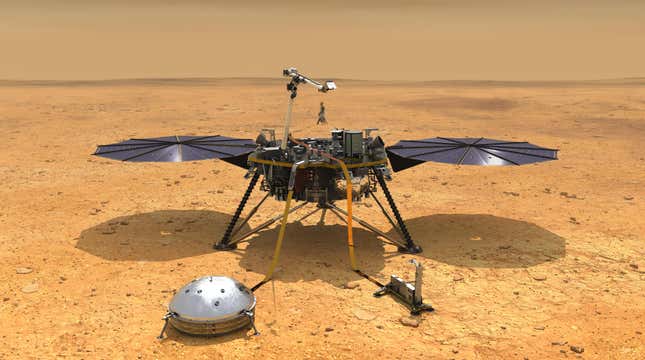
NASA has given up on the mole—a device that was supposed to dig deep into the Martian surface—after repeated failed efforts to make the system work. It was meant to be a major part of the InSight lander mission, but unfortunately Mars had other ideas.
“We’ve given it everything we’ve got, but Mars and our heroic mole remain incompatible,” said Tilman Spohn, principal investigator for the Heat Flow and Physical Properties Package (HP3) mission, in a NASA statement. “Fortunately, we’ve learned a lot that will benefit future missions that attempt to dig into the subsurface.”
One of those lessons is that Mars is full of surprises: In this case, the Martian regolith, or dusty surface material, didn’t behave as expected.
The German Aerospace Center (DLR) developed HP3 for the InSight mission, which landed on Mars in November 2018. The mole was supposed to take internal temperature readings of Mars at depths reaching 10 feet (3 meters). By doing so, scientists would have a better understanding of the warm internal processes that drive much of the planet’s geology and surface evolution. Trouble is, the 16-inch-long (40-centimeter) mole only managed to dig down a few inches.
The problems started shortly after the mole was deployed on February 28, 2019. Over the course of the past two years, the top of the mole only managed to clear the surface by around an inch. Farther into the ground it did not go, as the device couldn’t get the required friction for downward movement. NASA attributed the problem to “duricrust”—a compact, cement-like mixture in which granules stick together. This was not good for the mole, and something the team hadn’t anticipated, according to NASA.
But the team tried to make it work with various hacks, like using InSight’s robotic arm to pin the mole against the wall of its hole. As a last valiant attempt, the mole was programmed to execute 500 hammer strokes, which it did on January 9, 2021, but to no avail. NASA has now decided to cancel this part of the InSight mission.
“This is why we take risks at NASA—we have to push the limits of technology to learn what works and what doesn’t,” Thomas Zurbuchen, associate administrator for science at NASA headquarters, said in the statement. “In that sense, we’ve been successful: We’ve learned a lot that will benefit future missions to Mars and elsewhere, and we thank our German partners from DLR for providing this instrument and for their collaboration.”
With the mole now permanently retired, mission planners can look ahead to other things, such as burying the tether that transmits data and power from InSight to its seismometer. NASA hopes to reduce temperature changes that are producing unwanted crackling and popping sounds in the seismic signal. To date, the seismometer has detected nearly 500 Marsquakes.
Indeed, the show must go on for InSight, which was recently granted a mission extension along with the Juno probe in orbit around Jupiter. From now until December 2022, InSight will continue to monitor for Marsquakes, keep track of local weather, and perform a radio experiment to determine if the Martian core is in a solid or liquid state.
It’s a sad ending to the HP3 project, but this mole will eventually make for a remarkable souvenir once humans start to visit the Red Planet.